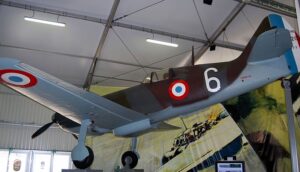Time Period: Post-WW2
Country of Origin: United States
Type: Fighter Aircraft
Manufacturer: North American Aviation
North American F-86 Sabre Aircraft Overview
The North American F-86 Sabre was a jet fighter aircraft developed in the late 1940s and early 1950s by North American Aviation for the United States Air Force. The F-86 was designed to meet the Air Force’s need for a high-performance jet fighter capable of countering Soviet MiG-15s in aerial combat during the Korean War.
The F-86 was powered by a single General Electric J47 turbojet engine and had a top speed of around Mach 0.9. It was armed with six .50 caliber machine guns and could carry a variety of bombs and rockets. The aircraft had a distinctive swept-wing design, which gave it excellent maneuverability and high-speed performance.
The F-86 quickly proved itself to be a highly effective fighter aircraft in combat, with many pilots crediting it with giving them a decisive advantage over the Soviet-built MiG-15s they faced in the skies over Korea. The F-86 went on to serve with distinction in a number of other conflicts, including the Taiwan Strait Crisis and the Vietnam War.
The F-86 also served as the basis for a number of other aircraft designs, including the F-86D Sabre Dog interceptor and the F-86F Sabre fighter-bomber. More than 9,800 F-86s were produced, and the aircraft served with dozens of air forces around the world. Today, the F-86 is considered a classic fighter aircraft and is widely admired for its contributions to the development of modern jet fighters.
North American F-86F-40-NA Specifications
- Crew: 1
- Length: 37 ft 1 in (11.30 m)
- Wingspan: 39 ft 1 in (11.91 m)
- Height: 14 ft 1 in (4.29 m)
- Wing area: 313.4 sq ft (29.12 m2)
- Airfoil: root: NACA 0009-64 mod.; tip: NACA 0008.1-64 mod.[116]
- Empty weight: 11,125 lb (5,046 kg)
- Gross weight: 15,198 lb (6,894 kg)
- Max takeoff weight: 18,152 lb (8,234 kg)
- Fuel capacity: JP-4 fuel:- 437 US gallons (364 imp gal; 1,650 L) internals + 2x 200 US gallons (170 imp gal; 760 L) drop tanks
- Powerplant: 1 × General Electric J47-GE-27 turbojet engine, 5,910 lbf (26.3 kN) thrust
North American F-86F-40-NA Performance
- Maximum speed: 687 mph (1,106 km/h, 597 kn) at sea level at 14,212 lb (6,446 kg) combat weight. 678 mph (589 kn; 1,091 km/h). 599 mph (521 kn; 964 km/h) at 35,000 ft (10,668 m) at 15,352 lb (6,964 kg). 597 mph (519 kn; 961 km/h) at 21,148 ft (6,446 m). 599 mph (521 kn; 964 km/h) at 22,835 ft (6,960 m)
- Stall speed: 124 mph (200 km/h, 108 kn)
- Range: 1,525 mi (2,454 km, 1,325 nmi)
- Combat range: 414 mi (666 km, 360 nmi) with two 1,000 lb (454 kg) bombs and 2x 200 US gallons (170 imp gal; 760 L) drop tanks
- Service ceiling: 49,600 ft (15,100 m) at combat weight
- Rate of climb: 9,000 ft/min (46 m/s) at sea level
- Time to altitude: 30,000 ft (9,144 m) in 5 minutes 12 seconds
- Lift-to-drag: 15
- Thrust/weight: 0.42
North American F-86F-40-NA Armament
- Guns: 6 X 0.50 in (12.7 mm) M3 Browning machine guns (1,800 rounds in total)
- Rockets: variety of rocket launchers; e.g.: 2 Matra rocket pods with 18 SNEB 68 mm rockets per pod
- Bombs: 5,300 lb (2,400 kg) of payload on four external hardpoints, bombs were usually mounted on outer two pylons as the inner pairs were plumbed for 2 200 US gallons (760 L) drop tanks which gave the Sabre a more useful range. A wide variety of bombs could be carried (max standard loadout being two 1,000 pounds [450 kg] bombs plus two drop tanks), napalm canisters and could have included a tactical nuclear weapon.
North American F-86 Sabre Image Gallery
More North American Aircraft

North American X-15
The X-15 is a hypersonic rocket-powered aircraft operated by the Air Force and the National Aeronautics and Space Administration.

North American F-82 Twin Mustang
The North American F-82 Twin Mustang was an American piston-engined fighter based on the North American P-51 Mustang and used in WW2.

North American P-64
The North American P-64 was an upgraded variant of the NA-50 fighter aircraft manufactured by North American Aviation in 1939.

North American P-51 Mustang
The North American P-51 Mustang is an American long-range, single-seat fighter and fighter bomber used during World War II.










